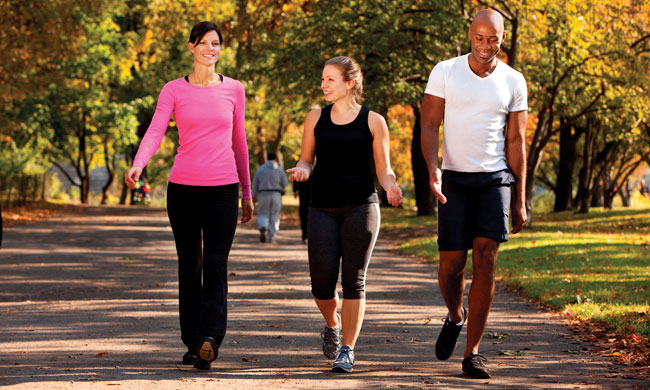HEALTHY LIVING
5 steps for safe fun in the summer sun

(Family Features) With an abundance of activities available throughout the summer months, from swimming and hiking to organized sports and spontaneous backyard games, the sunshine leads to fun almost everywhere you look. It’s important to keep in mind a few safety precautions to help enjoy those moments to the fullest, whether your family’s excitement takes place near the water, at the ballpark or around the neighborhood.
Consider this advice from the experts at the American Heart Association for a safe summer.
Stay Hydrated
Hot and humid months lead to more outdoor activities where the warm temperatures may lead to sweating and loss of fluids and electrolytes. Keeping the body hydrated is important for optimal functioning, especially in the heat. Be sure to drink plenty of water by bringing refillable water bottles and containers when summer calls for fun on the go. In addition to drinking plenty of water, you can supplement intake by eating foods with high water content like melons, lettuce and cucumbers. Be aware of the signs and symptoms of mild dehydration, including a dry or sticky mouth, headache, muscle cramps, fatigue or decreased urination. More severe cases may include nausea or vomiting, confusion, dizziness, rapid or irregular heartbeat, rapid breathing, seizures or unconsciousness.
Keep Skin Healthy
Taking steps to protect skin starts before you ever step into the sun, as it may be easy to get caught up in the joys of summer and forget about those damaging rays. Avoiding time spent outdoors in the midday hours helps limit exposure, but it also may not be realistic for busy families with sporting events, pool dates and more. Wearing sunscreen can help reduce the risk of sunburn, skin cancer and early onset of wrinkles; experts recommend using SPF 30 or higher at least 30 minutes before heading into the sun and reapplying at least every two hours throughout long days outdoors. Also consider wearing clothing that protects skin, such as sunglasses, a large-brimmed hat and light, long-sleeved shirts and pants.
Learn CPR
With summer comes rest, relaxation and fun, but it can also bring increased risk with more time spent in the heat and around water. An average of 33 drownings occur in the U.S. each day, according to the Centers for Disease Control and Prevention, with one-third of them proving fatal. Knowing CPR – cardiopulmonary resuscitation – could be the key to saving someone from cardiac arrest or drowning. If performed immediately, it can double or triple a cardiac arrest victim’s chance of survival, according to the American Heart Association. However, only about 40% of people who experience out-of-hospital cardiac arrest receive help before professionals arrive.
Because about 72% of out-of-hospital cardiac arrests happen in homes, you will likely be trying to save the life of someone you love – a family member, spouse, parent or friend – if called upon to perform CPR. Call 9-1-1, or send someone to do so, then push hard and fast in the center of the person’s chest until medical assistance arrives. Use an AED, if available, following the prompts. If you have been trained, have a pocket mask and are willing and able, give breaths as they are important for children and in situations like drowning. You can learn more about Hands-Only CPR and conventional CPR through resources provided due to the national support of Elevance Health Foundation.
Practice Safe Swimming
Splashing and swimming in a favorite pool, lake, river or ocean provides memories for a lifetime, but it can also be dangerous without the proper precautions. One of the most important steps is to ensure children know how to swim and understand it’s not OK to swim alone, even for adults. Wearing life jackets can prevent accidents whether you’re on a boat or in the water and designating an undistracted “water watcher” can help identify a dangerous situation before it develops.
Secure the Pool
Even when it’s not in use, a pool can be a hazard, particularly for families with young children who may be tempted to play while adults aren’t around. Installing fencing with self-closing gates at least 4 feet high around backyard pools can help separate playful children from dangerous situations. Additionally, be sure to stow away pool noodles, toys, floaties and other accessories once pool time is over to keep them out of sight and out of mind; these symbols of fun can cause temptation for little ones and lead them toward the water when there’s no supervision.
Find more ways to keep your family safe this summer by visiting heart.org.
Signs of Heat Stress
When those bright, sunny summer days call you and your loved ones outside, keep in mind these signs of heat illnesses like cramps, exhaustion or heat stroke. Even on days when it doesn’t seem extreme, heat and humidity can take their toll. If you experience any of these symptoms, find shade, take a break and drink water to cool your body temperature. However, if symptoms continue and worsen or do not improve with hydration and cooling, seek medical attention.
- Muscle pain, cramps or spasms
- Heavy sweating or loss of sweating
- Paleness
- Dizziness
- Headache
- Nausea or vomiting
- Confusion
- Fainting or unconsciousness
- High body temperature (greater than 100 F) with dry skin
- Rapid pulse
Photos courtesy of Getty Images
SOURCE:
American Heart Association
HEALTHY LIVING
Breathe better with asthma, wherever you are

(Family Features) If you have asthma, you know that symptoms can come on quickly, then worsen.
The things that make them do that are called triggers. An important part of managing asthma is knowing your triggers at home, work, school or while you’re outdoors.
A health care provider can help you figure that out, then you can take steps to avoid those triggers and breathe easier.
At Home
Because asthma is usually due to allergies, triggers are often allergens, or things that cause allergic reactions. Allergens such as pet dander, dust mites, pests and smoke can make asthma symptoms worse in some people, and for others, even trigger an asthma attack.
The National Heart, Lung, and Blood Institute (NHLBI) suggests that it may be helpful to combine a few different strategies to help reduce exposure to triggers.
People sensitive to dust can clean with a high-efficiency particulate air (HEPA) filtration vacuum and use mattress and pillow covers that prevent exposure to dust mites. If you’re sensitive to pests like cockroaches and rodents, consider integrated pest management, which involves removing and controlling pests through methods such as traps or poison. Avoiding tobacco smoke, including secondhand smoke, can be especially helpful for some people with asthma.
At School
Asthma is one of the leading reasons children miss school. At school, kids may be exposed to dust mites, pests and mold, which may be asthma triggers for some children.
Because children spend lots of time at school, it can be helpful for teachers, school nurses or coaches to know what to do if your child’s symptoms flare up. Team up with a health care provider to develop an asthma action plan and share it with trusted adults at your child’s school.
At Work
The workplace can have hundreds of potential triggers, like chlorine-based cleaning products, bleaches, hair dyes and metal dust. Repeated exposures in the workplace can also lead to new triggers. Report new or worsening symptoms that occur at work to your health care provider and your workplace supervisor.
Outdoors
Everyday weather like cold, dry air can set off breathing problems. Air pollution can affect asthma, too.
It may be helpful to avoid some of the worst pollution by adjusting when and where you exercise. Try to avoid exercising near busy roads or industrial areas. Visit airnow.gov to check your local air quality so you can plan to avoid outdoor activities when pollution is highest.
Managing your triggers is just one part of keeping your asthma under control. Work with a health care provider to develop an asthma treatment plan that includes taking medicines as prescribed and keeping track of your symptoms and where you are when they occur. That way, you can know what’s making your asthma worse or better.
To learn more about asthma, visit NHLBI’s Learn More Breathe Better® program at nhlbi.nih.gov/BreatheBetter.
Photo courtesy of Shutterstock
HEALTHY LIVING
Walk your way to better health

(Family Features) A walk is not just good for your body, it’s also good for your soul. Physical activity, like walking, is one of the best ways to reduce stress and boost your mood. However, reports show walking rates are declining steadily in the United States.
On average, 1 out of every 4 U.S. adults sits for longer than eight hours each day, per research from the Centers of Disease Control and Prevention, which can have negative consequences on physical and mental health. Regular exercise improves mood, boosts energy and can even help you sleep better. Staying active is one of the best ways to keep your mind and body healthy.
Consider this advice from the American Heart Association, which has worked for decades to promote policies and strategies that make it easier for communities to get and stay active. One example is National Walking Day on April 3, established by the organization to encourage people to move more throughout the day so they can feel, think, sleep and live better.
Indeed, adding more movement can benefit your body and mind in numerous ways, such as:
Lowering disease risk. Getting the recommended amount of physical activity (at least 150 minutes of moderate, 75 minutes of vigorous or a combination of those activities per week) is linked to lower risk of diseases, stronger bones and muscles, improved mental health and cognitive function and lower risk of depression, according to the U.S Department of Health and Human Services.
Increasing sunlight exposure. Outdoor exercise is an easy way to get moving and take in the sunlight, which can improve mood, boost immunity and help you get some vitamin D. Spending time outdoors is a no-cost option and has been shown to reduce stress, promote a sense of belonging and improve mood.
Improving cognitive and mental function. Physical activity keeps your mind sharp now and later. Studies show higher fitness levels are linked to better attention, learning, working memory and problem solving. What’s more, a study published in the “British Journal of Sports Medicine” shows people who get the recommended amount of physical activity are less likely to develop depression.
Living longer. Healthy life expectancy can be positively impacted by increasing activity. According to research published in the “American Journal of Epidemiology,” swapping just 30 minutes of sitting with low-intensity physical activity reduced risk of death by 17%.
Get moving to reduce your stress and step into better health. Learn more at heart.org/movemore.
Get Inspired to Get Moving
A little creativity can go a long way to make your walk more fun. You might think of walking as a solo activity, but a companion makes it even more enjoyable. Ask colleagues, friends or family to join you.
A walk is a perfect excuse to take a break from a long day at your desk. If you work remotely, take a conference call on the go or plan your walk as a reward for completing a project.
Use your walk as a guilt-free opportunity to listen to a new audiobook or create a walking soundtrack of your favorite upbeat music.
Mix up your scenery. Taking new routes keeps your walks interesting and helps prevent boredom from traveling the same predictable path.
If you need an extra nudge to get moving, a pet may help you get fit. Dog parents are more likely to reach their fitness goals than those without canine companions. In fact, according to the “Journal of Physical Activity & Health,” dog parents are 34% more likely to fit in 150 minutes of walking a week than non-dog owners. Pets can also help lower stress, blood pressure, cholesterol and blood sugar and boost your overall happiness and well-being.
Photos courtesy of Shutterstock
SOURCE:
American Heart Association
HEALTHY LIVING
A genetic connection to kidney disease

How APOL1-mediated kidney disease can impact you, your kidneys and your family
(Family Features) A genetic condition that can cause kidney failure, APOL1-mediated kidney disease (AMKD) represents a group of kidney diseases associated with mutations (changes or variants) in the apolipoprotein L1 (APOL1) genes.
Typically, the APOL1 genes – of which every person has two, one from each parent – create proteins that play a role in immunity. However, some people are born with mutations in one or both genes, and having mutations in both can increase the risk of developing kidney disease and even kidney failure.
In honor of National AMKD Awareness Day on April 30, consider this information from the experts at the American Kidney Fund to better understand the disease and become APOL1 aware.
Understanding Risk Factors
Research shows Black people with kidney disease are more likely to develop kidney failure than any other racial or ethnic group. The reasons for these health disparities include social determinants of health, a higher burden of diabetes and high blood pressure in the Black community, barriers to health care access and genetics.
The APOL1 gene mutations evolved over the past 3,000-10,000 years in people who lived in western and central Africa and are associated with increased protection from a parasite carried by the tse tse fly that causes African sleeping sickness. While protecting from one disease, the mutation – if inherited in both APOL1 genes – is more likely to lead to kidney disease in those of certain African descent, including people who identify as Black, African American, Afro-Caribbean or Latina or Latino.
In fact, an estimated 13% of Black Americans have two APOL1 gene mutations, according to the American Kidney Fund. While not everyone who has two APOL1 mutations will get kidney disease, there is a 1 in 5 chance they will go on to develop AMKD.
Identifying Symptoms
If you have kidney damage, symptoms may not occur until your kidneys are close to failing. As kidney damage worsens, one or more of these symptoms may occur:
- Protein in urine
- Swelling in legs or weight gain
- Feeling weak or tired
- High blood pressure
Should these symptoms occur and you have a family history of kidney disease, talk to a doctor about getting tested for kidney disease, as testing is the only way to determine kidney function. AMKD can cause damage to parts of the kidney that filter blood or, in some cases, cause cells in the kidneys to die, which can lead to damage and scarring that may eventually lead to kidney failure.
Getting a Diagnosis
The only way to know if you have APOL1 gene mutations is to do genetic testing via a blood or saliva sample. Genetic testing may be considered if you have kidney disease and don’t know the cause or if you’re considering donating a kidney. Testing may also be considered if a family member is a carrier for the mutation. If you have questions about genetic testing, discuss your options with a doctor or ask for a referral to a genetic counselor.
Taking Steps to Prevent Kidney Disease
There are currently no treatments available for AMKD. However, there are steps you can take to protect your kidneys and promote general health. Work with your doctor to create a plan to prevent or delay the progression of kidney disease, which may include:
- Doctor visits to check how your kidneys are working through urine and blood tests
- Checking for and managing diabetes and high blood pressure
- A healthy eating plan, which may involve limiting things like sodium (salt)
- Taking prescription medications as directed
- Being active at least 30 minutes each day of the week
- Quitting smoking or using tobacco
If you have the APOL1 gene mutations, you may be able to take part in clinical trials. Trials could provide an opportunity for researchers to develop and test safe treatments for AMKD. Also speak with family members about having genetic testing done if you have the mutation as they may also have it.
Learn more and find additional resources at kidneyfund.org/APOL1aware.
Photo courtesy of Shutterstock
SOURCE:
American Kidney Fund
-

 NEWS1 year ago
NEWS1 year ago2 hurt, 1 jailed after shooting incident north of Nocona
-

 NEWS6 months ago
NEWS6 months agoSuspect indicted, jailed in Tia Hutson murder
-

 NEWS1 year ago
NEWS1 year agoSO investigating possible murder/suicide
-

 NEWS1 year ago
NEWS1 year agoWreck takes the life of BHS teen, 16
-

 NEWS10 months ago
NEWS10 months agoMurder unsolved – 1 year later Tia Hutson’s family angry, frustrated with no arrest
-

 NEWS1 year ago
NEWS1 year agoSheriff’s office called out to infant’s death
-

 NEWS1 year ago
NEWS1 year agoBowie Police face three-hour standoff after possible domestic fight
-

 NEWS1 year ago
NEWS1 year agoDriver stopped by a man running into the street, robbed at knifepoint





